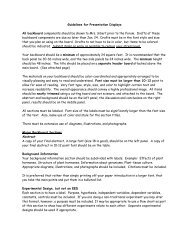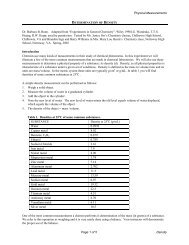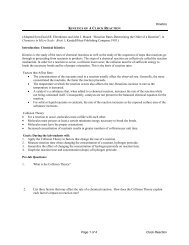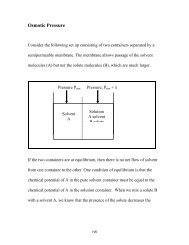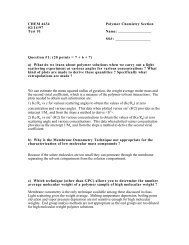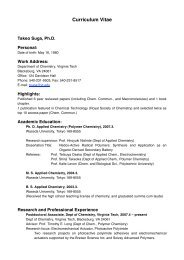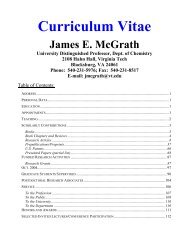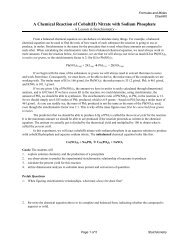Carlier Group Gaussian User Manual - Virginia Tech
Carlier Group Gaussian User Manual - Virginia Tech
Carlier Group Gaussian User Manual - Virginia Tech
You also want an ePaper? Increase the reach of your titles
YUMPU automatically turns print PDFs into web optimized ePapers that Google loves.
<strong>Carlier</strong> <strong>Group</strong> <strong>Gaussian</strong> <strong>User</strong> <strong>Manual</strong> 23<br />
27 25 12 11 S 2 10.0<br />
this would perform a series of constrained optimizations, where the 27 25 12 11 dihedral<br />
is first constrained to its original value, and then incremented twice by 10.0 degrees.<br />
Here S stands for ‘step.’ Note the use of the floating point number for the increment.<br />
27 25 12 11 30.0 S 8 10.0<br />
this would perform a series of constrained optimizations, where the 27 25 12 11 dihedral<br />
is first constrained to 30 degrees (different from its original value), and then incremented<br />
eight times by 10.0 degrees. Note the use of the floating point number for the<br />
increment.<br />
B. Multiple Constraints<br />
I have had occasion to perform optimizations with one fixed dihedral constraint and one<br />
dynamic dihedral constraint. As far as I can remember these have all failed. No<br />
atoms were shared in the constraints, and these calculations were also problematic in<br />
Spartan. What I have been able to do is perform optimizations with two fixed dihedral<br />
constraints<br />
C. Monitoring constrained optimizations<br />
To check conveniently--find out the internal coordinate name for your constraint--this will<br />
be R# for a bond length, A# for an angle, D# for a dihedral<br />
egrep D37 h0053.out<br />
this will show you the final value for your constraint<br />
when you have a series of calculations in the same job, and want to extract the<br />
energies,<br />
vim filename.out<br />
:/Summary<br />
this will take you to a list of eigenvalues left to right, under columns representing each<br />
optimized step in the calculation. The eigenvalue is the energy. Note that<br />
semiempirical energies are given in hartrees and are very small (since they reflect heat<br />
of formation, not electronic energy).<br />
If you want to get the geometries and energies out<br />
vim filename.out<br />
:/Optimized<br />
then scroll up to SCF done--your energy for the first optimization is here.



